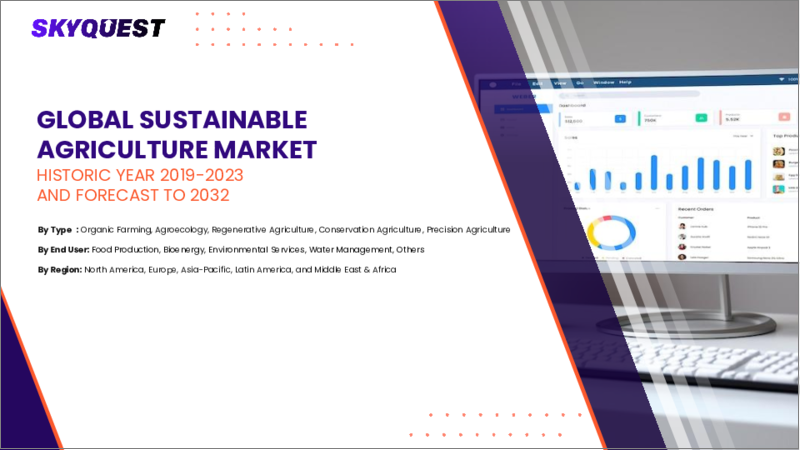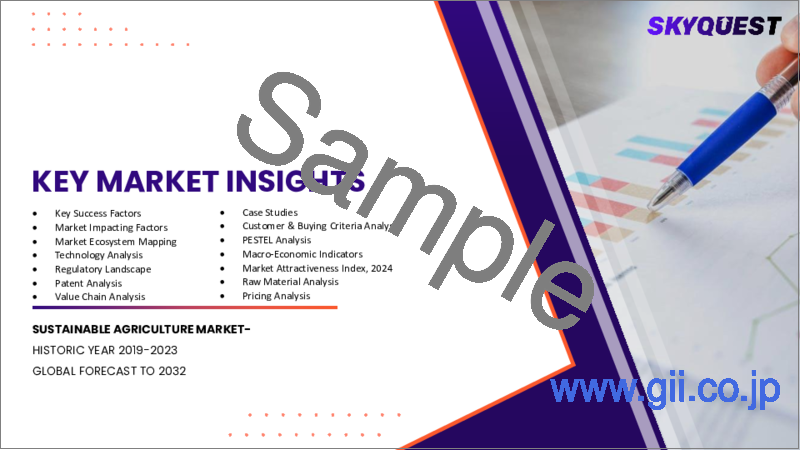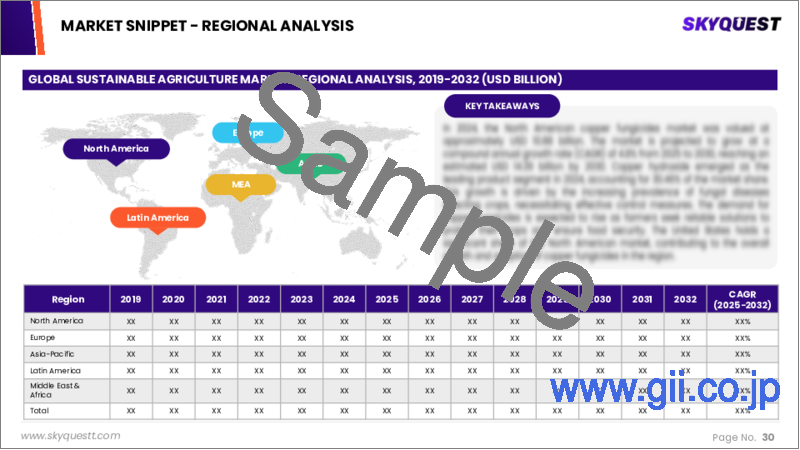|
|
市場調査レポート
商品コード
1633561
持続可能な農業の市場規模、シェア、成長分析:製品タイプ別、農業システム別、作物タイプ別、製剤別、用途別、地域別 - 産業予測、2025年~2032年Sustainable Agriculture Market Size, Share, Growth Analysis, By Product Type, By Farming System, By Crop Type, By Formulation, By Application, By Region - Industry Forecast 2025-2032 |
||||||
|
|||||||
| 持続可能な農業の市場規模、シェア、成長分析:製品タイプ別、農業システム別、作物タイプ別、製剤別、用途別、地域別 - 産業予測、2025年~2032年 |
|
出版日: 2025年01月12日
発行: SkyQuest
ページ情報: 英文 324 Pages
納期: 3~5営業日
|
全表示
- 概要
- 目次
持続可能な農業の世界市場規模は2023年に133億米ドルと評価され、2024年の146億6,000万米ドルから2032年には318億8,000万米ドルに成長し、予測期間(2025-2032年)のCAGRは10.2%で成長する見通しです。
世界の持続可能な農業市場は、環境に優しい食品オプションに対する消費者需要の高まりと政府の大幅な後押しを受けて、大きく拡大する見通しです。食品の選択が環境や社会に与える影響に関する意識が高まるにつれて、消費者は持続可能な方法で生産された製品をますます優先するようになり、強力な市場機会が創出されています。米国農務省の農業・食品研究イニシアティブや欧州連合の共通農業政策のような取り組みは、持続可能な慣行を採用する農家や研究者を支援する上で極めて重要です。精密農業や垂直農法における技術革新は、効率をさらに高め、エコロジカルフットプリントを削減します。高い導入コストや潜在的な収量の減少といった課題にもかかわらず、消費者の意識、政府の支援、技術の相互作用が市場の持続的成長を促し、将来の世代のための強靭な食糧システムを育むと予想されます。
目次
イントロダクション
- 調査の目的
- 調査範囲
- 定義
調査手法
- 情報調達
- 二次データと一次データの方法
- 市場規模予測
- 市場の前提条件と制限
エグゼクティブサマリー
- 世界市場の見通し
- 供給と需要の動向分析
- セグメント別機会分析
市場力学と見通し
- 市場概要
- 市場規模
- 市場力学
- 促進要因と機会
- 抑制要因と課題
- ポーターの分析
主な市場の考察
- 重要成功要因
- 競合の程度
- 主な投資機会
- 市場エコシステム
- 市場の魅力指数(2024年)
- PESTEL分析
- マクロ経済指標
- バリューチェーン分析
- 価格分析
- 規制分析
持続可能な農業市場規模:製品タイプ別& CAGR(2025-2032)
- 市場概要
- 種子と特性
- 生物農薬
- バイオ刺激剤
- その他
持続可能な農業市場規模:農業システム別& CAGR(2025-2032)
- 市場概要
- 有機農業
- 保全農業
- 総合的害虫管理
- 精密農業
持続可能な農業市場規模:作物タイプ別& CAGR(2025-2032)
- 市場概要
- 穀物
- 油糧種子および豆類
- 果物と野菜
- その他
持続可能な農業市場規模:製剤別& CAGR(2025-2032)
- 市場概要
- 液体
- 乾燥
持続可能な農業市場規模:用途別& CAGR(2025-2032)
- 市場概要
- 種子処理
- 土壌処理
- 葉面散布剤
- その他
持続可能な農業市場規模& CAGR(2025-2032)
- 北米
- 米国
- カナダ
- 欧州
- ドイツ
- スペイン
- フランス
- 英国
- イタリア
- その他欧州地域
- アジア太平洋地域
- 中国
- インド
- 日本
- 韓国
- その他アジア太平洋地域
- ラテンアメリカ
- ブラジル
- その他ラテンアメリカ地域
- 中東・アフリカ
- GCC諸国
- 南アフリカ
- その他中東・アフリカ
競合情報
- 上位5社の比較
- 主要企業の市場ポジショニング(2024年)
- 主な市場企業が採用した戦略
- 市場の最近の動向
- 企業の市場シェア分析(2024年)
- 主要企業の企業プロファイル
- 会社概要
- 製品ポートフォリオ分析
- セグメント別シェア分析
- 収益の前年比比較(2022-2024)
主要企業プロファイル
- Bayer AG(Germany)
- Corteva Agriscience(USA)
- Syngenta Group(Switzerland)
- BASF SE(Germany)
- Cargill, Incorporated(USA)
- Archer Daniels Midland Company(ADM)(USA)
- Novozymes A/S(Denmark)
- BioConsortia, Inc.(USA)
- Certis Biologicals(USA)
- Deere & Company(USA)
- Trimble Inc.(USA)
- AGCO Corporation(USA)
- Yara International ASA(Norway)
- The Mosaic Company(USA)
- Netafim Ltd.(Israel)
- Unilever PLC(UK/Netherlands)
- Nestle S.A.(Switzerland)
- Danone S.A.(France)
- Indigo Ag, Inc.(USA)
- Pivot Bio(USA)
結論と推奨事項
Global Sustainable Agriculture Market size was valued at USD 13.3 billion in 2023 and is poised to grow from USD 14.66 billion in 2024 to USD 31.88 billion by 2032, growing at a CAGR of 10.2% during the forecast period (2025-2032).
The global sustainable agriculture market is poised for significant expansion, fueled by a rising consumer demand for eco-friendly food options and substantial governmental backing. As awareness grows regarding the environmental and social impacts of food choices, consumers increasingly prioritize sustainably produced products, creating a robust market opportunity. Initiatives like the U.S. Department of Agriculture's Agriculture and Food Research Initiative and the European Union's Common Agricultural Policy are pivotal in supporting farmers and researchers in adopting sustainable practices. Technological innovations in precision agriculture and vertical farming further enhance efficiencies and reduce ecological footprints. Despite challenges such as high implementation costs and potential yield reductions, the interplay of consumer awareness, government support, and technology is expected to drive sustained market growth, fostering a resilient food system for future generations.
Top-down and bottom-up approaches were used to estimate and validate the size of the Global Sustainable Agriculture market and to estimate the size of various other dependent submarkets. The research methodology used to estimate the market size includes the following details: The key players in the market were identified through secondary research, and their market shares in the respective regions were determined through primary and secondary research. This entire procedure includes the study of the annual and financial reports of the top market players and extensive interviews for key insights from industry leaders such as CEOs, VPs, directors, and marketing executives. All percentage shares split, and breakdowns were determined using secondary sources and verified through Primary sources. All possible parameters that affect the markets covered in this research study have been accounted for, viewed in extensive detail, verified through primary research, and analyzed to get the final quantitative and qualitative data.
Global Sustainable Agriculture Market Segmental Analysis
Global Sustainable Agriculture Market is segmented by Product Type, Farming System, Crop Type, Formulation, Application and region. Based on Product Type, the market is segmented into Seeds and Traits, Biopesticides, Bio stimulants and Others. Based on Farming System, the market is segmented into Organic Farming, Conservation Agriculture, Integrated Pest Management and Precision Agriculture. Based on Crop Type, the market is segmented into Cereals and Grains, Oilseeds and Pulses, Fruits and Vegetables and Others. Based on Formulation, the market is segmented into Liquid and Dry. Based on Application, the market is segmented into Seed Treatment, Soil Treatment, Foliar Spray and Other. Based on region, the market is segmented into North America, Europe, Asia Pacific, Latin America and Middle East & Africa.
Driver of the Global Sustainable Agriculture Market
One of the primary drivers of the Global Sustainable Agriculture market is the rising demand for food, fueled by the continuous growth of the global population. As the number of people on the planet increases, the pressure to produce sufficient food to meet this demand intensifies. Sustainable agriculture practices play a crucial role in addressing this challenge, as they promote enhanced crop yields while prioritizing environmentally responsible techniques. By adopting methods that optimize resource utilization and minimize ecological impact, sustainable agriculture ensures a reliable food supply, thus compelling the market's growth in response to ever-growing consumer needs and preferences for sustainable food production.
Restraints in the Global Sustainable Agriculture Market
The global sustainable agriculture market faces several constraints, primarily driven by the high costs associated with adopting sustainable practices. Implementing environmentally-friendly methods frequently necessitates substantial investments in advanced technology, infrastructure upgrades, and specialized training. As a result, many farmers, especially those operating on a small scale, encounter challenges in transitioning to these more sustainable approaches. This financial burden can deter them from embracing necessary innovations, ultimately hindering the overall growth of the sustainable agriculture sector. Consequently, addressing these cost-related barriers is crucial to support wider adoption and foster a more sustainable agricultural ecosystem worldwide.
Market Trends of the Global Sustainable Agriculture Market
The Global Sustainable Agriculture market is witnessing a significant trend driven by rising consumer awareness regarding the environmental consequences of conventional farming practices. As consumers prioritize health and ecological sustainability, there is a marked shift toward organic and sustainably produced food products. This evolving consumer preference is compelling farmers and agricultural businesses to adopt eco-friendly practices that minimize carbon footprints and conserve resources. The trend is not only fostering innovation within agricultural technologies but also promoting transparency and ethical sourcing in food supply chains. As a result, the market for sustainable agriculture is poised for substantial growth, reflecting collective commitment to protecting the planet and ensuring food security.
Table of Contents
Introduction
- Objectives of the Study
- Scope of the Report
- Definitions
Research Methodology
- Information Procurement
- Secondary & Primary Data Methods
- Market Size Estimation
- Market Assumptions & Limitations
Executive Summary
- Global Market Outlook
- Supply & Demand Trend Analysis
- Segmental Opportunity Analysis
Market Dynamics & Outlook
- Market Overview
- Market Size
- Market Dynamics
- Drivers & Opportunities
- Restraints & Challenges
- Porters Analysis
- Competitive rivalry
- Threat of substitute
- Bargaining power of buyers
- Threat of new entrants
- Bargaining power of suppliers
Key Market Insights
- Key Success Factors
- Degree of Competition
- Top Investment Pockets
- Market Ecosystem
- Market Attractiveness Index, 2024
- PESTEL Analysis
- Macro-Economic Indicators
- Value Chain Analysis
- Pricing Analysis
- Regulatory Analysis
Global Sustainable Agriculture Market Size by Product Type & CAGR (2025-2032)
- Market Overview
- Seeds and Traits
- Biopesticides
- Bio stimulants
- Others
Global Sustainable Agriculture Market Size by Farming System & CAGR (2025-2032)
- Market Overview
- Organic Farming
- Conservation Agriculture
- Integrated Pest Management
- Precision Agriculture
Global Sustainable Agriculture Market Size by Crop Type & CAGR (2025-2032)
- Market Overview
- Cereals and Grains
- Oilseeds and Pulses
- Fruits and Vegetables
- Others
Global Sustainable Agriculture Market Size by Formulation & CAGR (2025-2032)
- Market Overview
- Liquid
- Dry
Global Sustainable Agriculture Market Size by Application & CAGR (2025-2032)
- Market Overview
- Seed Treatment
- Soil Treatment
- Foliar Spray
- Other
Global Sustainable Agriculture Market Size & CAGR (2025-2032)
- North America (Product Type, Farming System, Crop Type, Formulation, Application)
- US
- Canada
- Europe (Product Type, Farming System, Crop Type, Formulation, Application)
- Germany
- Spain
- France
- UK
- Italy
- Rest of Europe
- Asia Pacific (Product Type, Farming System, Crop Type, Formulation, Application)
- China
- India
- Japan
- South Korea
- Rest of Asia-Pacific
- Latin America (Product Type, Farming System, Crop Type, Formulation, Application)
- Brazil
- Rest of Latin America
- Middle East & Africa (Product Type, Farming System, Crop Type, Formulation, Application)
- GCC Countries
- South Africa
- Rest of Middle East & Africa
Competitive Intelligence
- Top 5 Player Comparison
- Market Positioning of Key Players, 2024
- Strategies Adopted by Key Market Players
- Recent Developments in the Market
- Company Market Share Analysis, 2024
- Company Profiles of All Key Players
- Company Details
- Product Portfolio Analysis
- Company's Segmental Share Analysis
- Revenue Y-O-Y Comparison (2022-2024)
Key Company Profiles
- Bayer AG (Germany)
- Company Overview
- Business Segment Overview
- Financial Updates
- Key Developments
- Corteva Agriscience (USA)
- Company Overview
- Business Segment Overview
- Financial Updates
- Key Developments
- Syngenta Group (Switzerland)
- Company Overview
- Business Segment Overview
- Financial Updates
- Key Developments
- BASF SE (Germany)
- Company Overview
- Business Segment Overview
- Financial Updates
- Key Developments
- Cargill, Incorporated (USA)
- Company Overview
- Business Segment Overview
- Financial Updates
- Key Developments
- Archer Daniels Midland Company (ADM) (USA)
- Company Overview
- Business Segment Overview
- Financial Updates
- Key Developments
- Novozymes A/S (Denmark)
- Company Overview
- Business Segment Overview
- Financial Updates
- Key Developments
- BioConsortia, Inc. (USA)
- Company Overview
- Business Segment Overview
- Financial Updates
- Key Developments
- Certis Biologicals (USA)
- Company Overview
- Business Segment Overview
- Financial Updates
- Key Developments
- Deere & Company (USA)
- Company Overview
- Business Segment Overview
- Financial Updates
- Key Developments
- Trimble Inc. (USA)
- Company Overview
- Business Segment Overview
- Financial Updates
- Key Developments
- AGCO Corporation (USA)
- Company Overview
- Business Segment Overview
- Financial Updates
- Key Developments
- Yara International ASA (Norway)
- Company Overview
- Business Segment Overview
- Financial Updates
- Key Developments
- The Mosaic Company (USA)
- Company Overview
- Business Segment Overview
- Financial Updates
- Key Developments
- Netafim Ltd. (Israel)
- Company Overview
- Business Segment Overview
- Financial Updates
- Key Developments
- Unilever PLC (UK/Netherlands)
- Company Overview
- Business Segment Overview
- Financial Updates
- Key Developments
- Nestle S.A. (Switzerland)
- Company Overview
- Business Segment Overview
- Financial Updates
- Key Developments
- Danone S.A. (France)
- Company Overview
- Business Segment Overview
- Financial Updates
- Key Developments
- Indigo Ag, Inc. (USA)
- Company Overview
- Business Segment Overview
- Financial Updates
- Key Developments
- Pivot Bio (USA)
- Company Overview
- Business Segment Overview
- Financial Updates
- Key Developments





